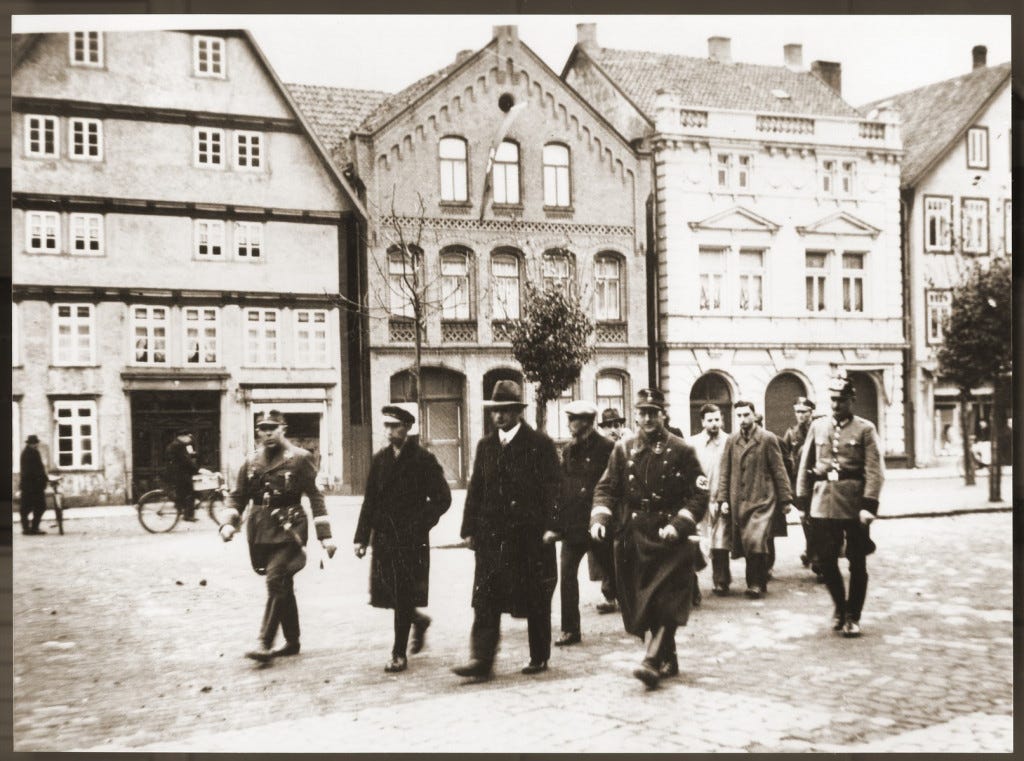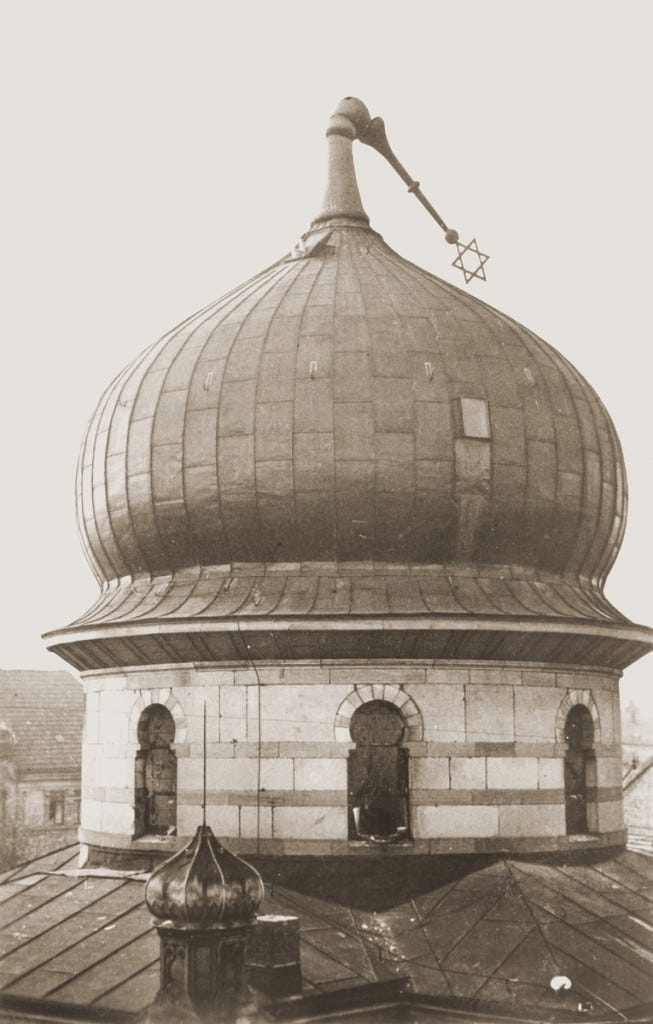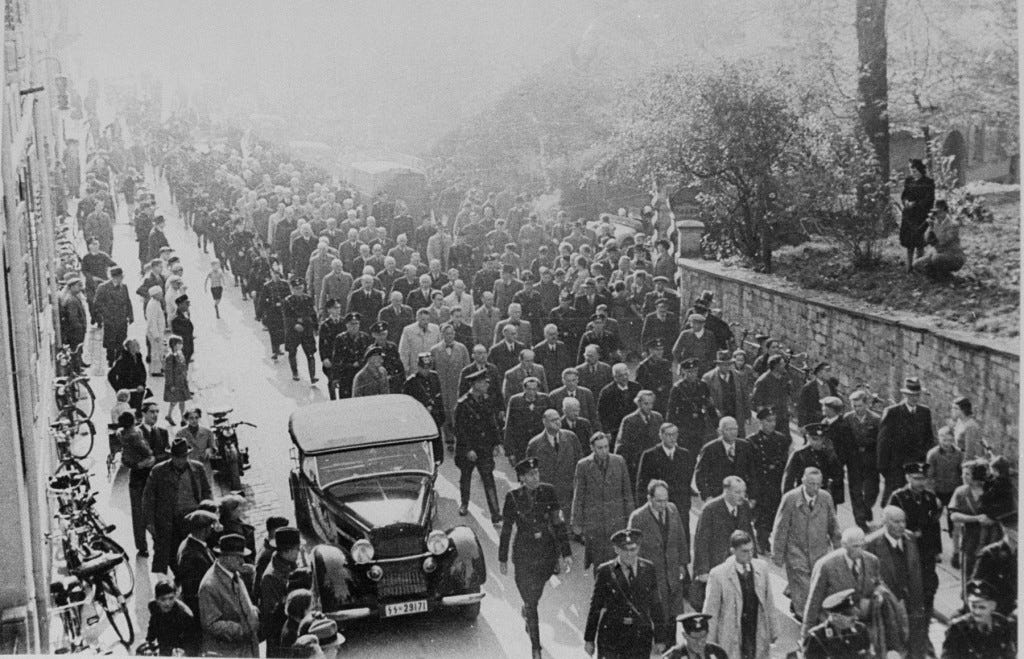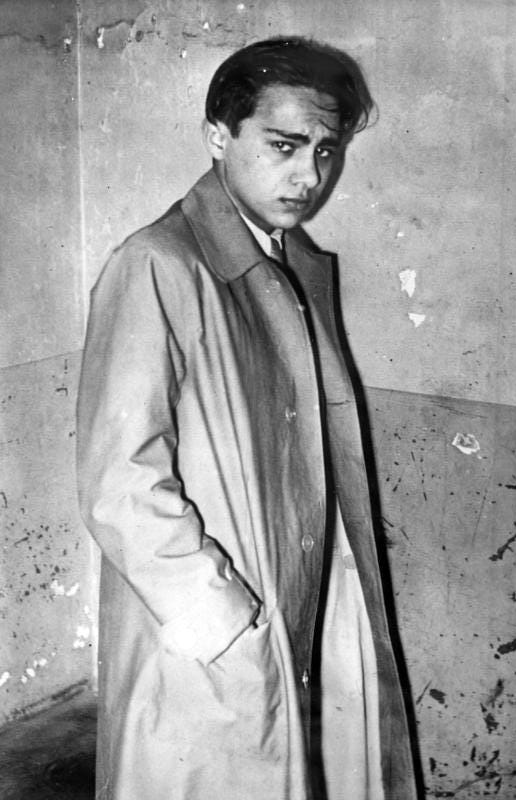Kristallnacht: The night the world took notice
Shortly after 9:35 a.m. on Nov. 7, 1938, a teenage refugee from Poland named Herschel Grynszpan talked his way into the second-floor office of Ernst vom Rath, a German diplomat working at his country's embassy in Paris.
Grynszpan, 17, had been born in Germany but was a citizen of Poland, his parents' birthplace. The family was Jewish, and that was the reason behind Grynszpan's visit to the embassy that morning. Two weeks earlier, German officials had ordered the deportation of all Polish Jews in the country, and the Grynszpans were among those rounded up and put on trains to Poland.
Herschel had moved to Paris in the fall of 1936 but had been living in France illegally for more than a year when he walked into the embassy at 78 Rue de Lille within days of hearing about his family's plight. Earlier that morning, the teenager had bought a gun and written a farewell note to his parents on a postcard, which he put in the pocket of his full-length raincoat.
He went to the embassy and asked to see the ambassador, Johannes von Welczeck, but was instead directed to vom Rath, a junior secretary. After making some sort of statement to the diplomat about avenging his countrymen, Grynszpan pulled out the pistol and fired at vom Rath from point blank range.
The initial Associated Press dispatch, which appeared in some U.S. newspapers the same day, said vom Rath was shot twice, in the shoulder and abdomen. The New York Times account the following day said three other bullets fired by Grynszpan lodged in the walls and ceiling. Other embassy officials rushed to the office after hearing the shots but Grynszpan gave himself up without a struggle and was turned over to French police. Vom Rath was rushed to a nearby clinic in critical condition.
German officials immediately seized on the shooting as a propaganda opportunity, with one state-run news service immediately blaming the attack on "international Jewry." In a story datelined Nov. 8 that appeared in the following day's editions, venerable New York Times Berlin correspondent Otto D. Tolischus described the scene this way:
The shots fired yesterday by a Polish emigre at Ernst vom Rath, Third Secretary of the German Embassy in Paris, were answered in the German press today with blazing wrath and a unanimous demand for retaliation against both German and foreign Jews in the Reich.
The assassination was branded "a new plot of the Jewish world conspiracy against National Socialist Germany, an attempt to torpedo Franco-German relations and a plot against European peace."
Tolischus went on to quote from the Nazi party newspaper Der Angriff, which wrote: "Nations of Europe, unite for ruthless war against the international Jewish menace and against Jewish murder and Jewish crime."
Because of this press campaign new fear is gripping the Jews of Germany, although excesses against them so far have been reported from only one town, Kassel, where a synagogue and Jewish shop windows were reported wrecked by a "spontaneous demonstration on the part of the population."
By the time many U.S. readers got to that final phrase, the wheels were in motion for far more widespread "spontaneous demonstrations" that appalled the world.
Ernst vom Rath died of his wounds around 5:30 p.m. on Nov. 9 -- the 15th anniversary of Hitler's Beer Hall Putsch. Party leaders had gathered in Munich to commemorate the occasion, and upon hearing of vom Rath's death propaganda minister Joseph Goebbels told the assembled crowd that "the Führer has decided that … demonstrations should not be prepared or organized by the Party, but insofar as they erupt spontaneously, they are not to be hampered."
The men in the room put out the word to their home regions and violence began in some cities before midnight. At 1:20 a.m. on Nov. 10, Reinhard Heydrich, head of the Security Police (which included the Gestapo), sent a telegram to police departments and Sturmabteilung (SA) leaders with instructions on how to proceed, which were then passed on to the street-level Brownshirts and Hitler Youth. Those directives made it clear that only German Jews were to be targeted in the "demonstrations."
That night and into the daylight hours on the 10th, hundreds of synagogues and thousands of Jewish-owned businesses across Germany and Austria were damaged or destroyed. The debris of countless shattered windows eventually gave the pogrom its name: Kristallnacht. Night of broken glass.
Such imagery was associated with the attacks from the beginning. The front-page account of the events in the Chicago Tribune by the paper's longtime Berlin correspondent, Sigrid Schultz, began this way:
The windows of almost all Jewish stores in Friedrichstrasse and Kurfuerstendamm, principal Berlin shopping thoroughfares, were smashed early today by wrecking gangs in civilian clothes who arrived in automobiles. They were armed with crowbars.
Many stores were looted. The occupants of some shops were dragged into the street and carried off. These were the biggest anti-Semitic raids ever carried out in Berlin. The raiders traveled from one Jewish store to the other to smash windows and scatter goods.
As Schultz's pointed inclusion of the phrase "civilian clothes" in her lead indicates, neither she nor other observers on the scene had any doubt these were officially sanctioned attacks. Schultz, 45, was born in Chicago but had lived in Europe since age 8, moving to Berlin during the Great War.
The Tribune hired her as a correspondent in 1919 and she chronicled the rise of the Nazi movement from the beginning, building relationships with its leaders over the years. As the extent of their plans became more evident and her accounts of their actions riled Nazi officials, she eventually began to write under the pseudonym "John Dickson" to maintain her safety.
Though her story is a rather straightforward blow-by-blow of the destruction, her disgust is evident.
On Wittenbergplatz Nazis burned part of the decorations and the altar cloths of a synagogue. A small dark pile of the burned material was still glowing at 5 o'clock this morning. The inside of the synagogue has been smashed to pieces. Police held back those who were trying to catch a glimpse of the wreckage.
The Nazis hired thirty taxis on the Doenhoffplatz at 2 a.m. and drove to the synagogue, which was in the West End. They emerged a few minutes later carrying out in triumph an embroidered cloth and other decorations and drove back to Wittenbergplatz. They bought gasoline from a taxi driver and set fire to the synagogue's decorations. The Nazis then traveled down Tauentzienstrasse where Jewish shops were being smashed by the wrecking gangs.
Tolischus' ties to Germany were similarly deep. He had been born in East Prussia (now Lithuania) in 1890 and emigrated to the U.S. as a teenager, eventually attending journalism school at Columbia University before returning to Europe. Aside from short stints in London and the U.S., he had been based in Berlin since 1923 and had worked for the Times there since 1933.
His initial story on the events of Nov. 9 and 10 too more of a big-picture perspective and immediately pegged it as a historic moment.
A wave of destruction, looting and incendiarism unparalleled in Germany since the Thirty Years War and in Europe generally since the Bolshevist revolution swept over Great Germany today as National Socialist cohorts took vengeance on Jewish shops, offices and synagogues for the murder by a young Jew of Ernst vom Rath, third secretary of the German Embassy in Paris.
Beginning systematically in the early morning hours in almost every town and city in the country, the wrecking, looting and burning continued all day. Huge but mostly silent crowds looked on and the police confined themselves to regulating traffic and making wholesale arrests of Jews "for their own protection."
All day the main shopping districts as well as the side streets of Berlin and innumerable other places resounded to the shattering of shop windows falling to the pavement, the dull thuds of furniture and fittings being pounded to pieces and the clamor of fire brigades rushing to burning shops and synagogues. Although shop fires were quickly extinguished, synagogue fires were merely kept from spreading to adjoining buildings.
As far as could be ascertained the violence was mainly confined to property. Although individuals were beaten, reports so far tell of the death of only two persons -- a Jew in Polzin, Pomerania, and another in Bunzdorf.
In extent, intensity and total damage, however, the day's outbreaks exceeded even those of the 1918 revolution and by nightfall there was scarcely a Jewish shop, cafe, office or synagogue in the country that was not either wrecked, burned severely or damaged.
Tolischus went on to quote a "proclamation" from Goebbels that offered up a smug defense of the destruction: "The justified and understandable anger of the German people over the cowardly Jewish murder of a German diplomat in Paris found extensive expression during last night. In numerous cities and towns of the Reich retaliatory action has been undertaken against Jewish buildings and businesses."
The account noted that "thousands of Jews, mostly men," had been arrested and various embassies and consulates in Berlin and elsewhere across Germany "were besieged by frantic telephone calls and by persons, particularly weeping women and children, begging help that count not be given them."

Though Tolischus went on to list the names of specific businesses that had been targeted in Berlin and cities in which similar riots had occurred, adding: "in general the press follows a system of reporting only local excesses so as to disguise the national extent of the outbreak, the full spread of which probably never will be known."
One overriding truth stuck out to him about the day's events, however: "All pretense -- maintained during previous comparatively minor anti-Jewish outbreaks -- to the effect that the day's deeds had been the work of irresponsible, even Communist, elements was dropped this time and the official German News Bureau, as well as newspapers that hitherto had ignored such happenings, frankly reported on them."
A threshold had been crossed, and the world took notice.
In England, The Guardian editorial board was one of many to focus on the wildly disproportionate response and the transparent origins of the outburst with this piece in its Nov. 11 editions:
Those who were first to deplore Herr vom Rath's murder will be the most horrified at the "revenge" the German Government has taken on a people which can have had nothing to do with the irresponsible act of a desperate youth.
The burnt synagogues, the wrecked shops, the unrestrained looting, with their aftermath of suicides and pitiable attempts to leave the country, are described by Dr. Goebbels as springing from "the justifiable and comprehensible indignation of the German people."
No one who knows the Germans will lay these brutalities to their charge; the attacks on the Jews are the responsibility of a fanatical Government whose uniformed henchmen were first in this cruel outburst of destructiveness and whose police did nothing to stop it. ...
This is a form of "justice" which the outside world will not understand. It might have been thought that the German Government, after its recent triumphs, would have at last marked out for itself a manner of behaviour more suited to the dignity of a great sovereign State.
It might have been thought that a Government which proclaims itself qualified to control the destinies of native peoples would have respected the rights of its citizens of another race. Such expectations have been violently disappointed.
A New York Times editorial the same day took a similar tack, beginning with a sympathetic portrait of Grynszpan before expressing disgust at the facade the Nazis attempted to erect around the day's events in claiming the violence was carried out by unsanctioned "mobs."
The patriots arrived in automobiles, went about he work of destruction with method and precision, wore the boots which go with the uniform of Storm Troopers and other Nazi units. The police looked on until, after fourteen hours of violence, the orgy was officially called off by Dr. Goebbels.
Thus does a great Government take revenge for the act of a maddened boy, a Government which exercises supreme and unquestioned power over 80,000,000 people, boasts of the order it maintains and aspires to spread this order over all of Central Europe.
Recently this Government has extended its domain with the consent of the Western Powers, who acquiesced in its bloodless victories as the prelude to European appeasement. Instead they were the prelude to the scenes witnessed yesterday, scenes which no man can look upon without shame for the degradation of his species.
But perhaps the more interesting commentary came from an outlet all too familiar with the topic. The Wisconsin Jewish Chronicle printed just once a week, on Friday. While its front page on Nov. 11 included coverage of the previous day's violence, the paper stuck with the lead editorial it already had in place -- a piece that repeatedly condemned Grynszpan's actions.
Under the headline "One Jew Commits Violence," the paper acknowledged that while the young man's actions were understandable -- "The wonder is that with all the unbelievable tortures perpetrated upon the Jewish people for over five years this act of insanity was not committed a thousand times" -- they also were unacceptable, given the inevitable repercussions.
We condemn this act of assassination vigorously and without reservation of any kind. It was as futile as it was un-Jewish, and anti-Jewish. It took the life of one man who was merely a symbol of Nazi injustice. And it condemned to death and torture and untold suffering the innocent lives of thousands of Jews and the destruction of their property. It gave the Nazis the justification they craved for retaliation and revenge.
One week later, however, with plenty of time to absorb the reality of the horrors that had transpired across the ocean, the Jewish Chronicle struck a vastly different tone.
In an editorial perhaps three times as long as the previous Friday's offering and dotted with words and phrases written in all capital letters, the newspaper lashed out in an extraordinary screed at a Nazi regime it had warned about for half a decade:

Having exhausted our vocabulary in attempting to set down in words our feelings of wonderment, revulsion and condemnation of the barbaric acts of the Nazi German government during the past five years, we are at a loss to know just how to give expression to our feelings in the latest and most astonishing act of Nazi savagery.
We experience a sense of relief in the fact that we do not have to search the dictionary for adjectives and synonyms to fulfill our obligation to express the Jewish viewpoint on the most devastating of all pogroms in history. The daily newspapers, the radio, the pulpit, and all other forms of communication are carrying all the words and expressions that the English language affords. We are weary of repeating them. They have become almost impotent and meaningless to us from constant never-ending usage.
And we feel a sense of relief in the fact that it is no longer necessary for us to sound a Jewish note in these events, for they are no longer JEWISH. The Nazi pogrom is no longer considered an assault against Jews and Judaism. It is now recognized for what it always was -- an assault upon Civilization itself, an assault upon Christianity, Protestant as well as Catholic, an assault upon law and morality by any other name one chooses to call these concepts of human decency.
No longer need the Jew protest alone. It is not his own fight anymore. It never was, of course, but the Christian world never gave much evidence of its own realization and consciousness of that fact. But it DOES NOW!
Somehow, though, even after spilling such breathtakingly righteous condemnation across the page, the newspaper concluded with a staggering underestimation of the hold its nemesis already had on his subjects:
We are equally certain that the military might of America will not be necessary to check the Scourge of Civilization. It will fall and crumble in its own rottenness and at the hands of the very German people who have fallen victims to its poison and who will feel deeply the shame and dishonor that has befallen them. Hitler is fighting his last "kampf" with God Almighty and Humanity.

As attuned as American Jews were to Hitler's motives and capabilities -- particularly compared to the population at large -- even they could never have foreseen the unspeakable horrors that would follow in the years to come.
While the Nazis had a long track record of anti-Jewish activity, the U.S. Holocaust Memorial Museum notes that Kristallnacht represented the first time the regime "incarcerated Jews on a massive scale simply on the basis of their ethnicity."
An estimated 30,000 Jewish men were sent to concentration camps at Dachau, Buchenwald and beyond in the days after the attacks. At the time, those names didn't represent what they do now. Though numerous inmates died in them, many of the men rounded up after Kristallnacht eventually were released after promising to leave Germany.
But the wheels were now irrevocably in motion, and from Nov. 10 on, the Nazi-run government instituted increasingly harsh regulations that stripped Jews of nearly every conceivable right or privilege.
By the time the coming global catastrophe concluded in mid-1945, an estimated six million Jews -- two-thirds of Europe's pre-war Jewish population -- were dead.





